Campaign History of the 151e Régiment d'Infanterie - XXVIV
~ 1918 ~
End of the War (8 September - November)
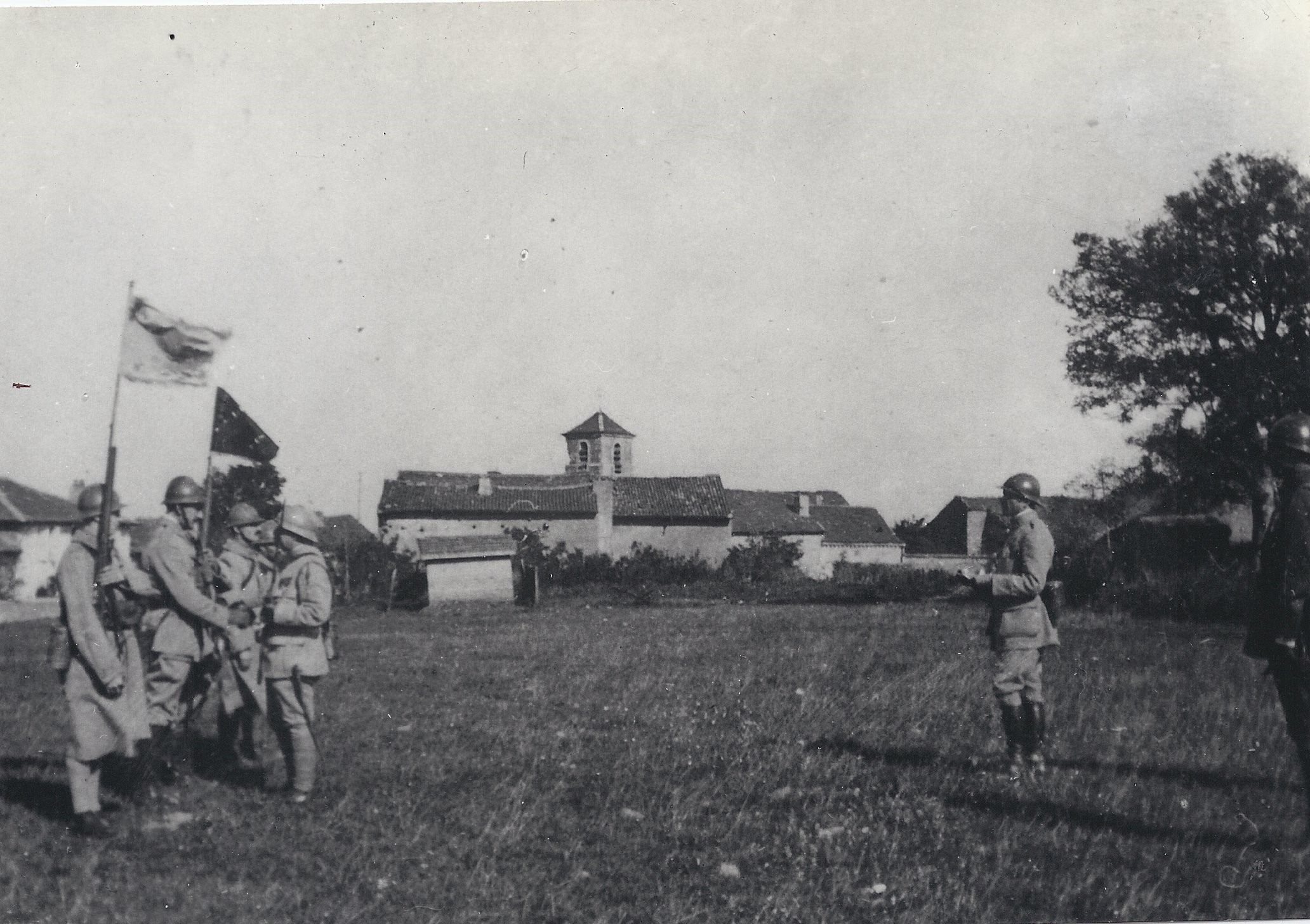
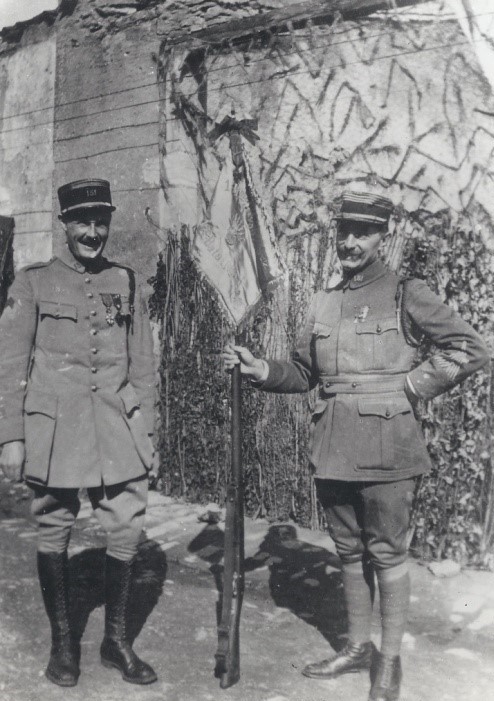
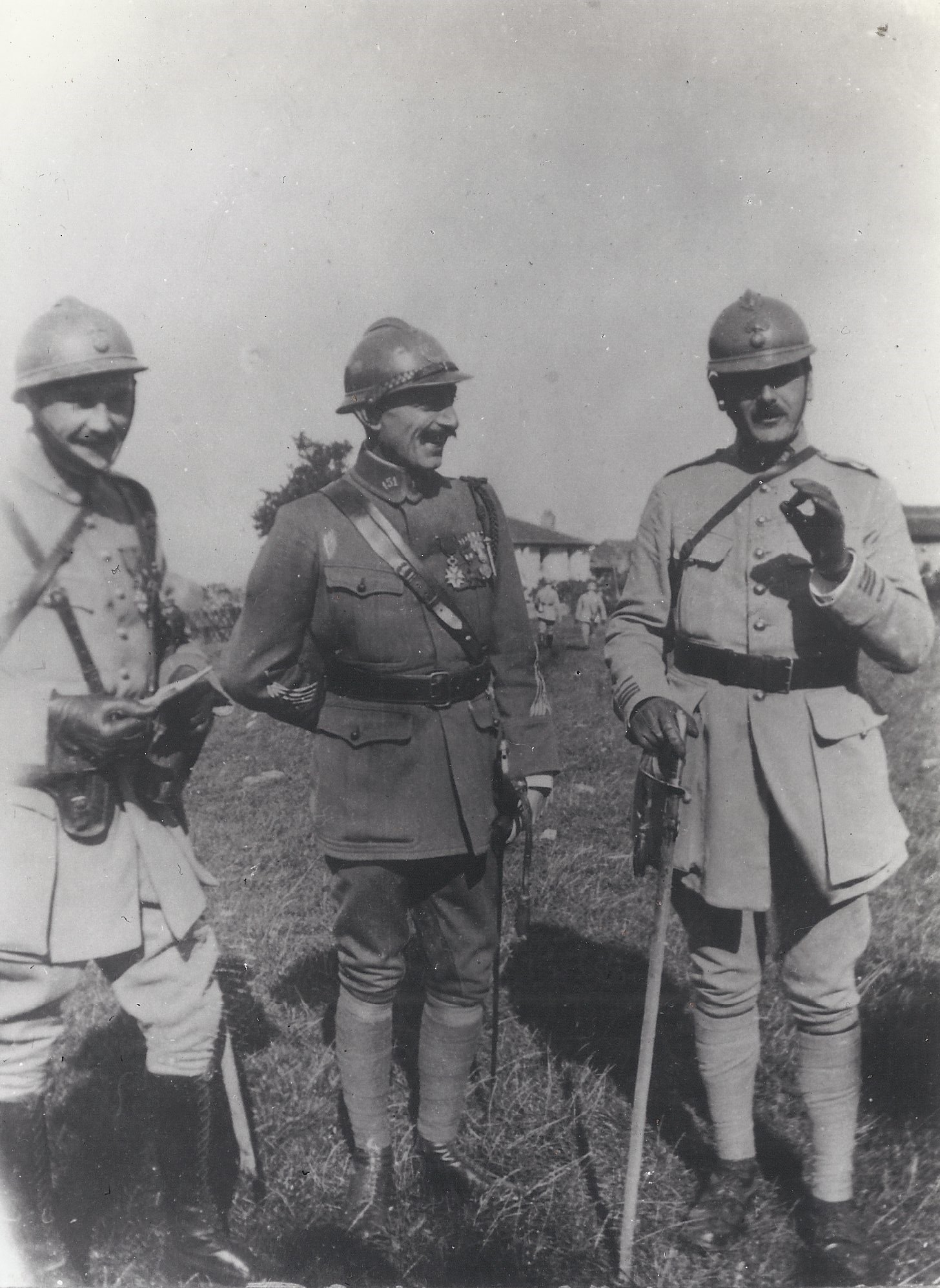
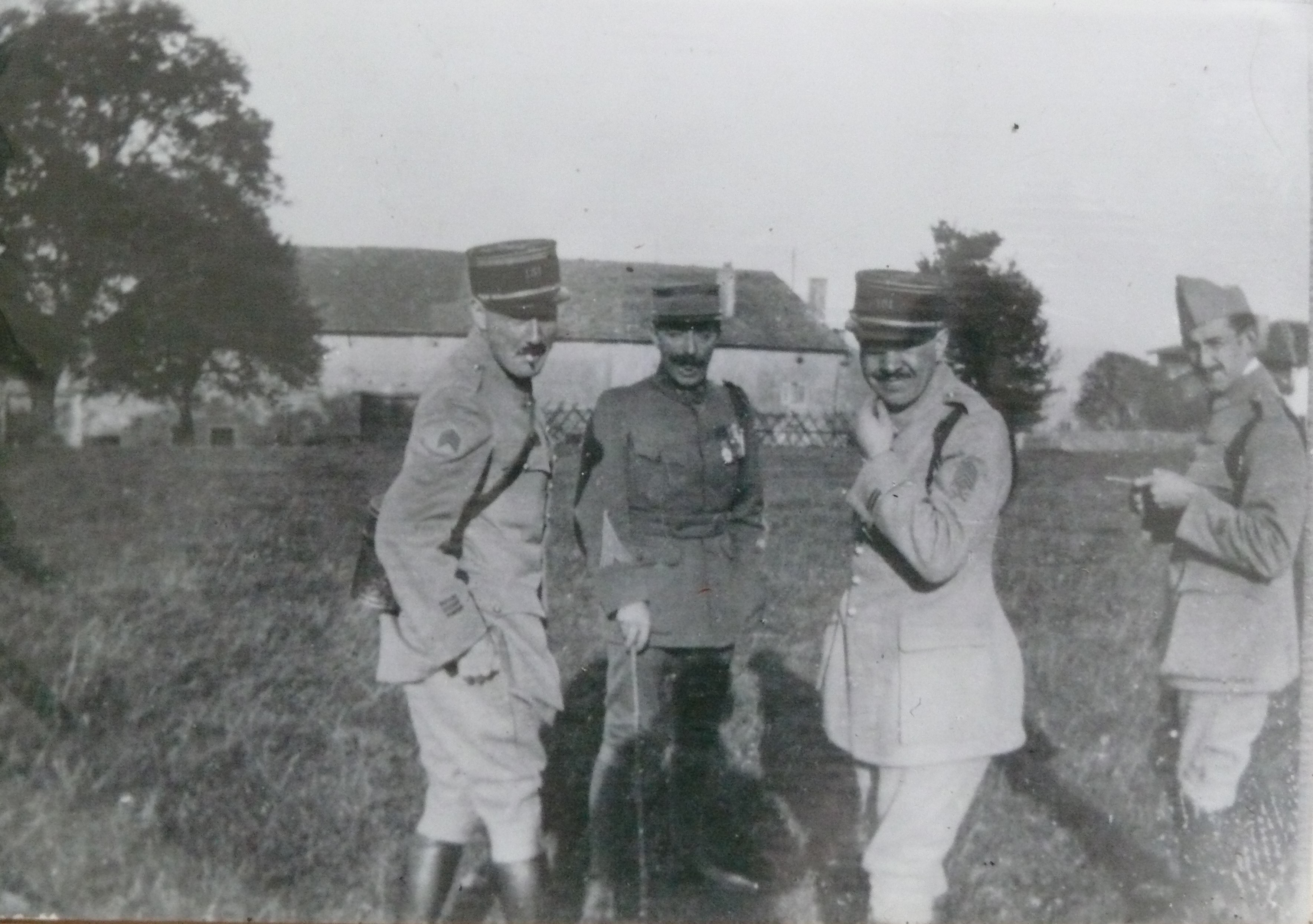
Decoration ceremony near Ste. Geneviève for actions taken on 28 Aug. 1918 at Soissons. From left to right: Lieut.-Col. Perchenet pinning the Croix de Guerre to the fanions of 2 Co. and 1 MG Co. cited in the Orders of the Army Corps for their determined action in crossing the Aisne River. Capt. Adjt.-Major Bourgoin and Cmdt. Caisez (commanding 1 Bat.) displaying the fanion of 1 Bat., which has been decorated with Croix de Guerre (with palm) for its actions in crossing the Aisne River. Capt. Adjt.-Major Bourgoin, Cmdt. Caisez, Cmdt. Le Boulanger (Adjoint du chef de corps). Capt. Adjt.-Major Bourgoin, Cmdt. Caisez, Lieut. Cabillic (commanding 1 MG Co.), and Sous-Lieut. Gatin (2 Co.).
8-19 September: The regiment is at rest in its billets at Boissy-Fresnoy, Villers-Saint Genest, and Betz. Sous-Lieut. Gastin is brevetted to lieutenant. On 10 Sept., a detachment of reinforcements arrives from the Centre d'Instruction Divisionnaire (CID) composed of 1 aspirant, 10 sergents, 17 caporaux, and 139 men. On 12 Sept., Sous-Lieut Foureaux coming from CID is assigned to 5 Co. Sgt. Machu (5 Co.) and Sdt. Gaudiche (2 MG Co.) receive the Médaille Militaire decorated with the Croix de Guerre with palm. Sdts. Caubréa (11 Co.) and Fresnel (5 Co.), Cpl. Pierrat (11 Co.) receive the Médaille Militaire. On 15-16 Sept., the 151 boards four trains at the Nanteuil [-le-Haudouin] station and are taken to Ludres. The 1 Bat. billets at Chavigny, 2 Bat. at Ludres, and 3 Bat. at Meissein. On 17 Sept., regiment senior commanders perform a reconnaissance of the regiment's new sub-sector Sainte Geneviève, about 3km north east of Pont-à-Mousson. In the evening the 2 and 3 Bats. march to the forest where the advanced-guard is situated to bivouac for the night. Capt. Pey, previously wounded and evacuated, returns and takes command of 3 Bat., while Capt. Benoit retakes command of 11 Co.
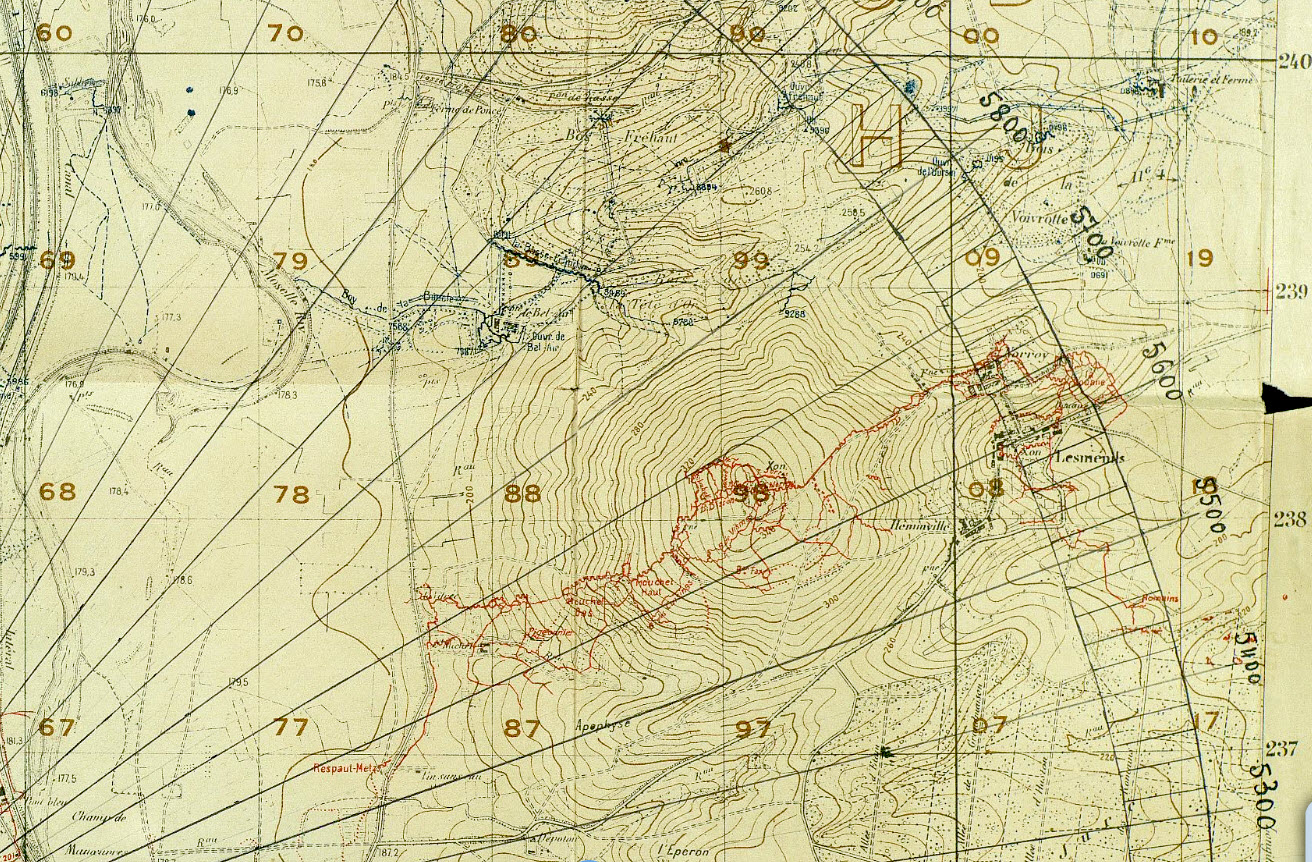
Map of the Sainte Geneviève sector in September 1918. (source: JMO 162 RI. Original map is here).
20-22 September: The 2 Bat. relieves a battalion of the US 326 IR (82 ID) in the first line of the center sector, while 3 Bat. goes into support in the Forêt de Facq to relieve another battalion of the same unit. The 1 Bat. and the CHR goes to bivouac at the advanced-guard. On 18 Sept., a detachment of reinforcements arrives from the CID composed of 12 men. The next night 1 Bat. moves to billets at Sainte Geneviève (5 km southeast of Pont-à-Mousson), relieving elements of the US 326 IR. On the night of 21-22 Sept., American tanks will circulate close to the lines to create a diversion and determine the reaction of the enemy artillery. The following individuals receive the Médaille Militaire: Sdt. Joseph Lauchet (5 Co.), Cpl-Four. Henri Laurent (1 Co.), Sgt. Pacifique Perron. Médecin Major 2e Cl. Dreneau coming from the 18 BI Indo-Chinois is assigned to the 151 as Médecin-Chef. Capt. Lefébvre coming from the 94 RI (depot) is assigned as adjudant-major of 3 Bat. The night of 22-23 Sept. the American tanks perform the same operation.
23-24 September: German artillery becomes more active and a great activity of vehicular traffic is heard coming from the enemy rear lines. An operation is planned for the next day with the goal of taking the enemy first line from the Moselle River to the Bois de la Voivrotte. For the operation, the following elements will participate: a groupe-franc of the 151 (composed of 1 officer, 2 NCOs, 3 corporals and 25 men), a groupe-franc of the 162 RI, an American company (200 men) and a company of Senegalese (100 men), and six teams of engineers. Armaments to be employed include: four 37mm guns, eight Stokes mortars, ten machine guns, supported by a group of 155mm court and three groups of 75mm. The detachment will be commanded by Capt. Besth of the 29 BTS. The mission of the groupe-franc of the 151 is to protect the right flank of the Senegalese company and the occupation of Bois de la Voivrotte. In case of counter-attack, the group will protect the withdrawal of the Senegalese company and then return to the lines. On the night of 23-24 Sept. patrols circulate out to establish the best base of departure at Ferme de Bel Aire and the area north of Norroy. At 0400 hrs on 24 Sept. the attack units are to be in position and the attack will begin at 0430 hrs under protection of a rolling barrage (speed: 100 meters every three minutes). Losses on 23 September include 1 killed and 2 wounded.
In the event, the attack is postponed 24 hours. Enemy artillery remains active from 0300 to 0600 hrs, maintaining a harassing fire with HE and poison gas shells on the regiment's first lines in the Bois du Turé, Bois de la Fourasse and Forêt de Facq. Sous-Lieut. Tournier coming from CID returns to the regiment and is assigned to 3 MG Co. A detachment of reinforcements arrives from the CID composed of 1 adjudant, 1 sergent, 3 caporaux and 18 men. Losses on 24 September include 3 wounded.
25 September: At 0500 hrs, the operation is carried out on the Bois de la Voivrotte in liaison with the units facing the 162 RI sector, which must take Bois Frehaut (sp?). The groupe-franc (30 men) of the 151 under the command of Sous-Lieut. Le Ridant. The group takes its objective and establishes listening posts at the northern edge of the woods. At 1000 hrs, an enemy force attempts to infiltrate the regiment's lines but is repulsed. From then until 1300 hrs, a strong bombardment is opened on the Bois de la Voivrotte. At 1715 hrs an intense bombardment is opened between the Moselle and the Seille Rivers seeming to presage an enemy counter-attack. At 1750 hrs, the enemy artillery seems to lengthen its fire and a counter-barrage is requested. At 1800 hrs, the enemy counter-attacks along the entire front of the regiment. The elements in the Bois Frehaut are quickly forced to retreat and regroup. At 1900 hrs orders are given to Sous-Lieut. Le Ridant to fall back with his detachment, who at this time was in contact with the enemy, who was infiltrating the woods, flanking it from the east and west despite the uninterrupted fire from the detachment's rifle and machine-gun fire. Sous-Lieut. Le Ridant and the detachment engage in a savage hand-to-hand fight and at 1930 hrs and is only able to make it back to friendly lines (by way of Narroy) around 2100 hrs. The fight was very hard and the enemy bombardments violent. Chef de Bataillon Caisez is promoted as officier de la Légion d'Honneur, Asp. Albert Béhazue (5 Co.), Sdt. Alphonse Belleculée (2 Co.), Médecin Sous-Aide Major Jean Perlis (1 Bat.) receive the Médaille Militaire. Losses on 25 September include 2 evacuated.
26-30 September: Gradually the sector calms down, with the artillery fire diminishing in intensity. At 0530 hrs, reconnaissance patrols are sent out to the Bois Fréhaut and the Bois de la Voivrotte. The patrols are fired up from the northeast corner of the Bois Fréhaut and the southern edge of the Bois de la Voivrotte. The impression by the patrol leaders is that the southern part of the Bois Fréhaut and the Bois de la Voivrotte are strongly occupied by the enemy. During the enemy counter-attack on 24 September at 1900 hrs, a combat group composed of gunners (with 1 gun) from 1 MG Co. and some grenadiers resisting at the northeast corner of the woods could not reached to inform them of the orders to fall back owing to ferocious hand-to-hand encounter. This group detached group holds back the enemy all night long. At dawn it breaks contact and rushes back behind the enemy lines, moving along the lines for a kilometer before finding a gap and making it back to French lines to the east of Bois de la Voivrotte. The general commanding the division recommends the Médaille Militaire to Corporal Henri Richon (1 MG Co.), the group leader, and a citation in the orders of the division for the other men.
In the evening of 27 September enemy artillery opens up a harassing fire with 105s, 150s, and poison gas shells. The 3 Bat. relieves the 2 Bat. at the advanced-posts, with the latter going back to billets at Sainte Geneviève. The 3 Bat. has been replaced in the Schwarble quarter by 1 Bat. Losses on 27 Sept. include 3 killed and 29 missing (incl. Le Tollec). The next day the enemy carries out numerous harassing fires. A large number of motor cars and trucks behind the enemy’s lines can be heard, and small groups of men can be seen moving around. Losses on 28 Sept. include 5 gassed. The harassing fire and intense motor vehicle circulation continues the next two days and night. Losses on 29-30 Sept. include 2 wounded and 1 gassed. On 30 September the 103 BTS is put at the disposition of the 151 RI, with the battalion being billeted at Bezaumont.
1-31 October: By order of the commanding general, one company per battalion is dissolved and its effectives amalgamated into the ranks of the other companies. Consequently, the 3, 7, and 9 Companies cease to exist and the regiment is reduced to battalions comprised of two infantry companies and one machine gun company. At the same time, the Senegalese companies from the 103 BTS (3 in total) are attached to each of the 151’s battalions. On 2 October, there is only light enemy artillery activity and the circulation of motor vehicles behind the enemy’s lines is less pronounced. The following day there are habitual harassing fires conducted by the enemy. The 3 Co. of the 103 BTS relieves the 9 Co. of the 151 RI, the effectives of which will disperse into the other companies.
On 2 October, there is only light enemy artillery activity and the circulation of motor vehicles behind the enemy’s lines is less pronounced. The following day there are habitual harassing fires conducted by the enemy. The 3 Co. of the 103 BTS relieves the 9 Co. of the 151 RI, the effectives of which will disperse into the other companies. Losses on 3 October include 6 gassed. On the night of 4 Oct., 3 Bat. is relieved in the advanced posts by 1 Bat., with the 3 Bat. marching to Sainte Geneviève. The 2 Bat. marches to Schwaeble. On 5 October, a detachment of reinforcements arrives from the Centre d'Instruction Divisionnaire (CID) composed of 3 sergents, 5 caporaux, and 59 men. There’s light artillery action the next day. Losses on 6 October include 1 wounded. The following day, American officers conduct a reconnaissance of the sub-sector. Losses on 7 October include 2 wounded. On 8 October, the 1 Bat. is relieved in the advanced post by a battalion of the US 326 IR, with the 1 Bat. going off to billet at Millery. The next night, 2 and 3 Bats. are relieved by two battalions of the US 326 IR. Cmdt. Caisez is evacuated due to illness. On 10 Oct. the 1 and 3 Bats. and the CHR are billeted at Nancy and the Caserne Molitor, the 2 Bat. at Marbache.
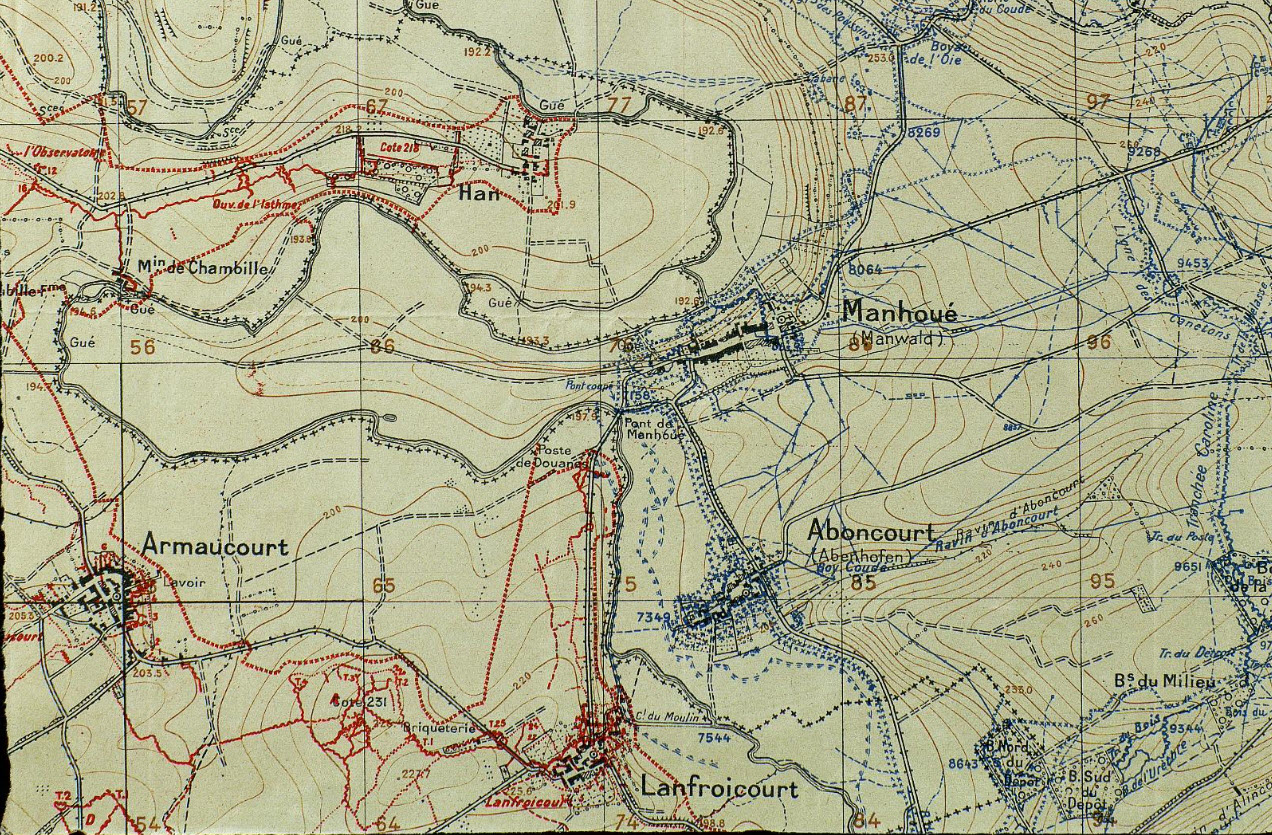
Map of the Armaucourt - Manhoué - Han sector in October 1918. (source: JMO 162 RI. Original map is here. ).
On 11 October the officers of the 151 go off to reconnoiter the regiment’s new sub-sector of Bouxières-aux-Chènes. The 2 Bat. marches from Marbache to Bouxières-aux-Chènes where it billets for the night. The Senegalese company joins it there. On 12 October, the 1 and 3 Bats. along with their Senegalese companies depart Nancy in order to relieve two battalions of the 332 RI in the second position at Ecuelle. On the night of October 13, the 2 Bat. relieves in the advanced posts a battalion of the 332 RI. The sector proves to be a quiet one, with almost no enemy activity to speak of. Patrols are routinely sent out to the Bois Robinson and to the left bank of the Seille River but are by and large uneventful. The men are put to work improving their entrenchments. Following a raid by the 162 RI, German artillery fire picks up somewhat. On 20 October the 2 Bat. is relieved in the advanced posts by the 3 Bat. On 21 October a detachment of reinforcements arrives from CID composed of 2 caporaux and 8 men.


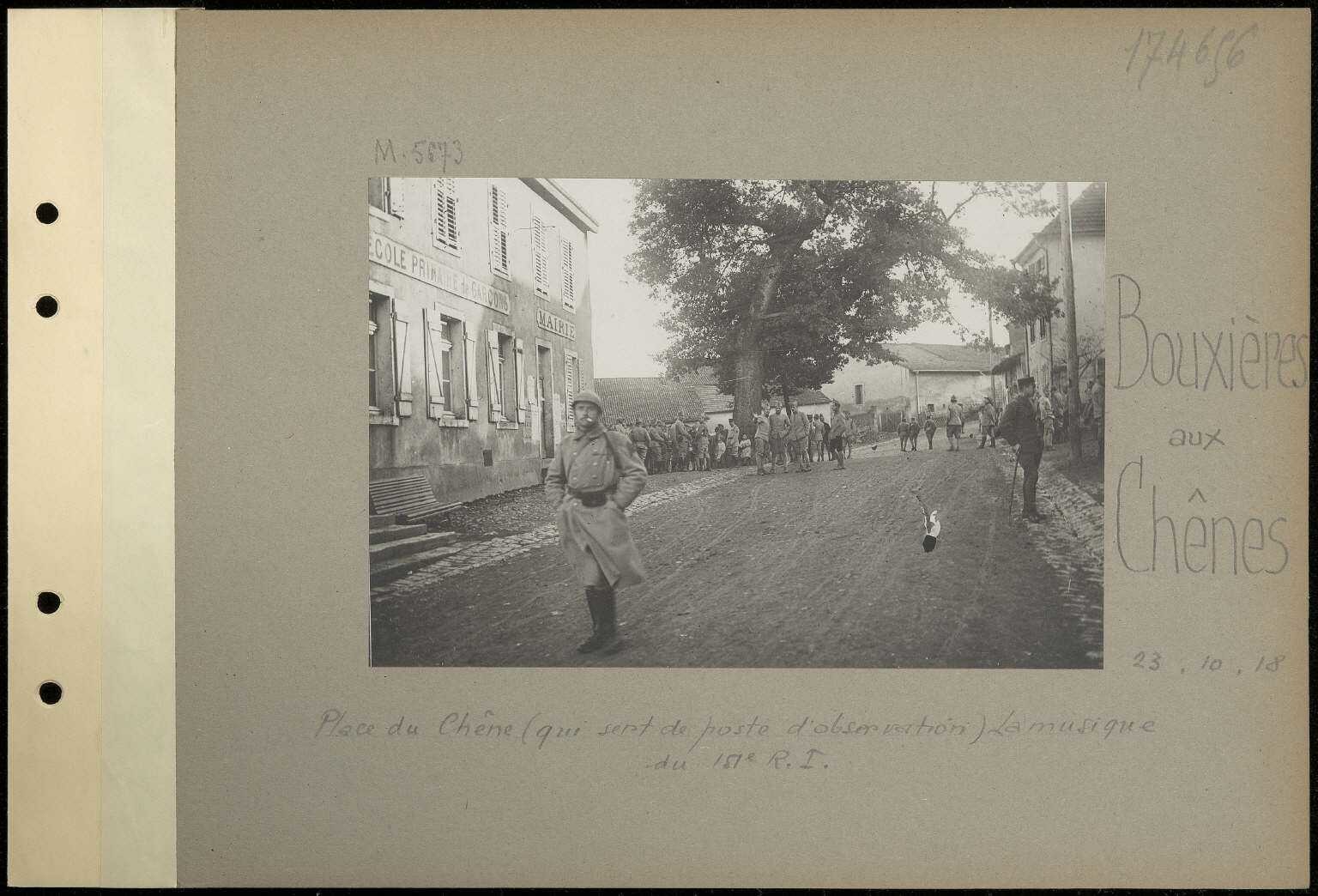
The regimental band of the 151e RI. Place du Chêne (which served as an observation post), Bouxières-aux-Chênes - 23 October 1918. Source: Vallois collection.
On the night of 21-22 October an ambush is set up and a reconnaissance made of the Manhoué bridge, which was previously demolished and is unusable. The recon patrol is fired on by a machine-gun located in the western part of the village. The next day, a regulated artillery fire is carried out. Patrols are sent out by the companies in the advanced posts to reconnoiter the river crossings for the purpose of laying an ambush the following night. Another patrol reconnoiters two points for establishing footbridges over the Seille to the northeast of the Bois 81.30. Work continues on the entrenchments and the two battalions in the second position receive instruction. The next night the ambush is laid but reports no activity. On 25 October Lieut. No'l coming from the CID is assigned to 2 MG Co. On the night of 26 October the 3 Bat. is relieved in the advanced posts by 1 Bat. Work on the trenches and routine patrols continue to be carried out and ambushes set but with no results, the enemy infantry remaining passive. On 30 October a detachment of reinforcements arrives from CID composed of 13 caporaux and 152 men to bring the regiment up to its regulation strength. The next day Lieut. Vincent Le Ridant (1 MG Co.) is promoted to the Légion d’Honneur and Sdt. Maurice Baillot (CHR) receives the Médaille Militaire.
The following soldiers are awarded the Médaille Militaire between 1-17 October: Cpl. Amiet Delacourt (11 Co.), and Sdts. Maurice Ledain, Julien Holleback (2 Co.), Victor Angot (2 MG Co.), Louis Emelin (3 Co.), Raymond Garby (5 Co.), Francois Geraud (9 Co.), Maurice Boileau (10 Co.), Auguste Hardouin (10 Co.). Médecin Major 2 cl. Maupin is promoted Chevalier de la Légion d’Honneur.
As a side note, the following transfers are made between 1-17 October. Lieut. Bugnot returns from convalescence and is assigned to 2 Co. Sous-Lieut. Lucien coming from CID is assigned to 6 Co. Lieut. Diévart and Lieut. Gatin are transferred to the 500 RAS (tanks). Lieut. Métais, commanding the special section, takes command of 10 Co. Capt. Martini coming from 163 RI becomes the adjoint-major of the 151. Sous-Lieut Millietcoming from CID takes command of the special section of the 69 DI. Capt. Pegon and Lieut. Duclos return from the 151 depot at Quimper and are assigned to 1 and 5 Cos., respectively. Sous-Lieut. Pelaprat is transferred from 11 to 9 Co. Lieut. Bergier is transferred to the Eastern Army. Médecin Aide Major 2 cl. Velleau de la Brumière is transferred to the 268 RAC. Chef de Bat. Pey departs to become the director of the grenadiers program at Blainville and Capt. Lefèbvre takes command of 3 Bat., replacing Capt. Pey. Lieut. Plifferling takes command of 2 Co., replacing Capt. Teyssier who takes command of 1 Bat. Chef de Bat. Le Boulanger departs to take command of the 59 BCP. Lieut. Bugnot takes command of 2 Co. Capt. Bourgoin departs to start up the general-staff program. Capt. Crochet takes command of 1 Bat. Cmdt. Caisez is chef de Etat-Major of 2 DI. Capt. Teyssier takes command of 2 Co.
As the war entered its fifty-second month and peace negotiations between the major powers were unfolding, military commanders were still actively prosecuting a war against an enemy whose forces in the field were still very capable of fighting back. Chilling orders came down to the 151 stating that preparations were to be made for a new offensive through Lorraine in the direction of Bensdorf set to begin on 14 November.
1-10 November: The day is calm. The men busy themselves with working on their positions. Sdt. Cyprien Fraissinel is awarded the Médaille Militaire. A patrol the next day near the area of Lanfroicourt reports the sound of vehicles circulating. Sdt. Clément Munier (10 Co.) and Sdt. Jean Leroux (10 Co.) are awarded the Médaille Militaire. The week remains quiet with routine patrols reporting no activity and only weak artillery fire from the enemy. On 6 November the 103 BTS leaves the sector and is quits the 151 definitively. A battalion of the 233 RI is put at the disposition of the 151 for the defense of sub-sector Bouxières. On 8 November a patrol from the regiment escorts a reconnaissance by the engineers verifying the state of the roads in the sub-sector. Patrols the next night to the Manhoué bridge receives a lively fire coming from the village. All through the afternoon and evening of 10 November, the German forces on the opposite side of the Seille sent up an abundance of flares and signal rockets. Lieut.-Colonel Martin from the 69 RI is assigned to the 151 RI as Lieut.-Colonel Perchenet is put on inactive duty. In the evening the regiment is alerted that the enemy may be falling back. Orders went out to prepare for an attack the next day at noon.
11 November: While the troops readied themselves for what they believed would be the coming offensive through Lorraine, one they assumed would take the war into its fifth year, incredible rumors began to circulate that a formal ceasefire was to be called on 11 November. The unit commanders of the 151 were convinced that the enemy was planning a retreat. To ascertain the German plans, Lieutenant Basteau (who’d been given command of 5 Company) was ordered to take his unit on night reconnaissance from their positions at Armaucourt and, crossing over the Seille, determine whether Manhoué was occupied by the enemy. If it was not, he must hold it with his company and await the advance of the rest of 2 Battalion the next morning. Unbeknownst to Basteau at the time was that he was leading the final operation of the war for the 151. Having brought along a specially trained sentry dog, Basteau deployed his platoons into the frigid night. Through a thick fog, he quietly pushed his patrol parties up to a belt of German wire. As they began clipping the wire, a flare immediately shot up from Manhoué, piercing the heavy fog below. Ahead of them a sub-machine gun let loose a burst of gunfire, the rounds passing high overhead. Waiting a few hours, they tried clipping the wire again to see if the enemy was still there and the answer came in a second burst of fire, with one of the bullets sadly killing the sentry dog.
As dawn approached on 11 November, a liaison runner arrived and told Basteau the operation had been cancelled. An armistice had been signed. Basteau was skeptical of this news and he ensured his patrols took all the usual precautions as they crossed back over the river. There a mobile field kitchen served them hot coffee spiked with liquor before returning to Armaucourt. Once arrived, the news was confirmed – there was to be an immediate cessation of hostilities starting at 11.00 am. The men of the 151 now waited anxiously for the fateful hour to arrive. Finally, at eleven in the morning, on the eleventh day, of the eleventh month, the war ended. At the appointed hour, the regimental band struck up the "Marseillaise" and then played the "Marche Lorraine," while from every chest came the cry "Vive la France!" That afternoon and throughout the night, all along the line impromptu firework displays lit up the sky from both the French and German sides, as the troops shot off stockpiles of signal rockets and flares. Sdt. August Bordinat describes the day:
So what a joy, at about 7 o'clock on the morning of the 11 November...when I learned that the armistice was signed. On all fronts starting at noon, there was to be an immediate cessations of hostilities. I say to myself: "So long, noon attack!" With one or two other soldiers, we showered this happy day with a vintage Nancy wine. Not being in too much of a hurry now, I made my way along tranquilly and found my battalion partying on the banks of the Seille, opposite Manhoué, from where the regiment was to depart if the attack had taken place. What mayhem, I tell you! Joyously at night we made a grand fireworks display never the likes of which has been seen before. The Boches did the same, using up all existing stocks, and throughout the whole night and into the next day, it was non-stop illuminations in the sky from one camp to the other.
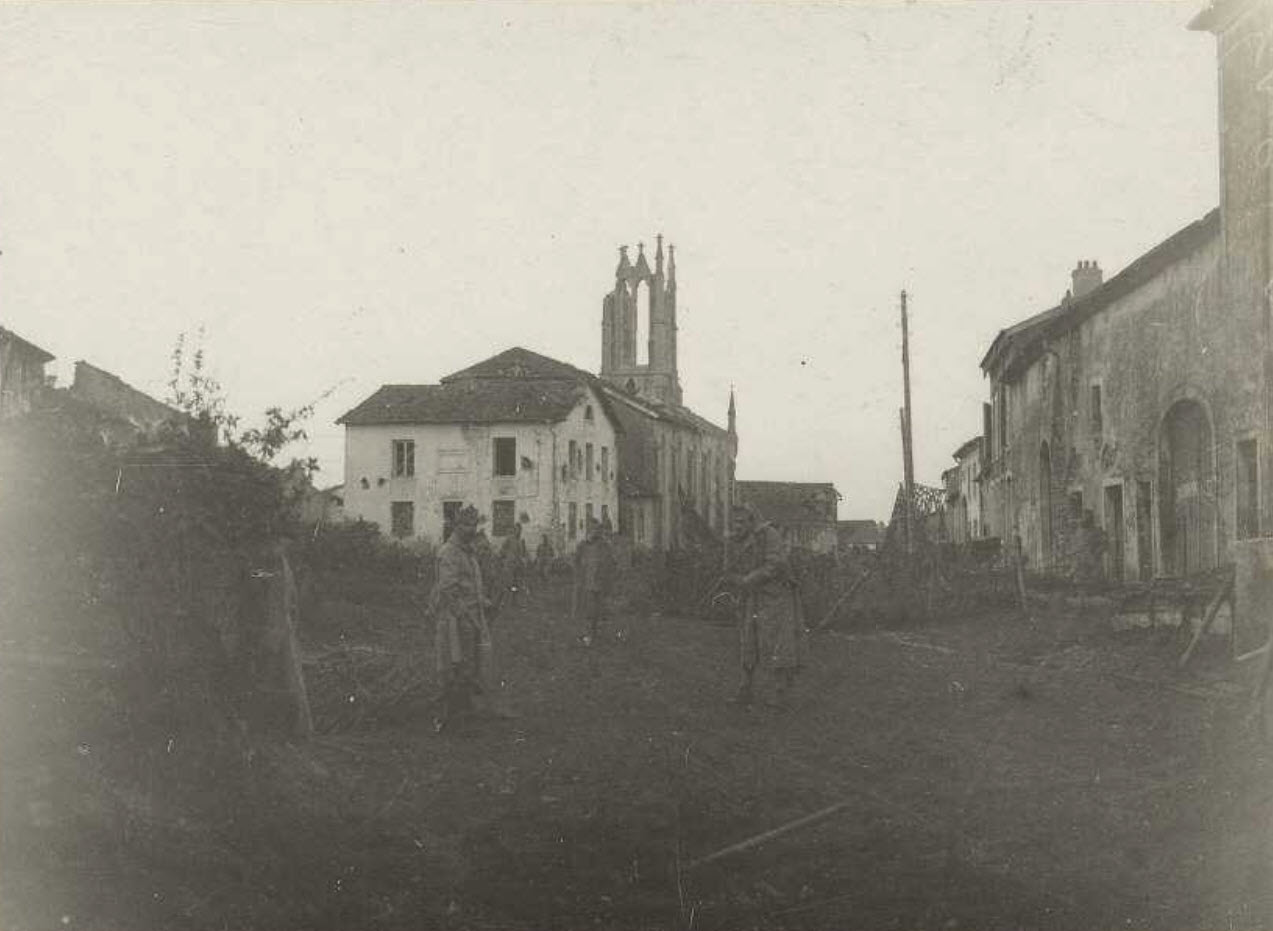
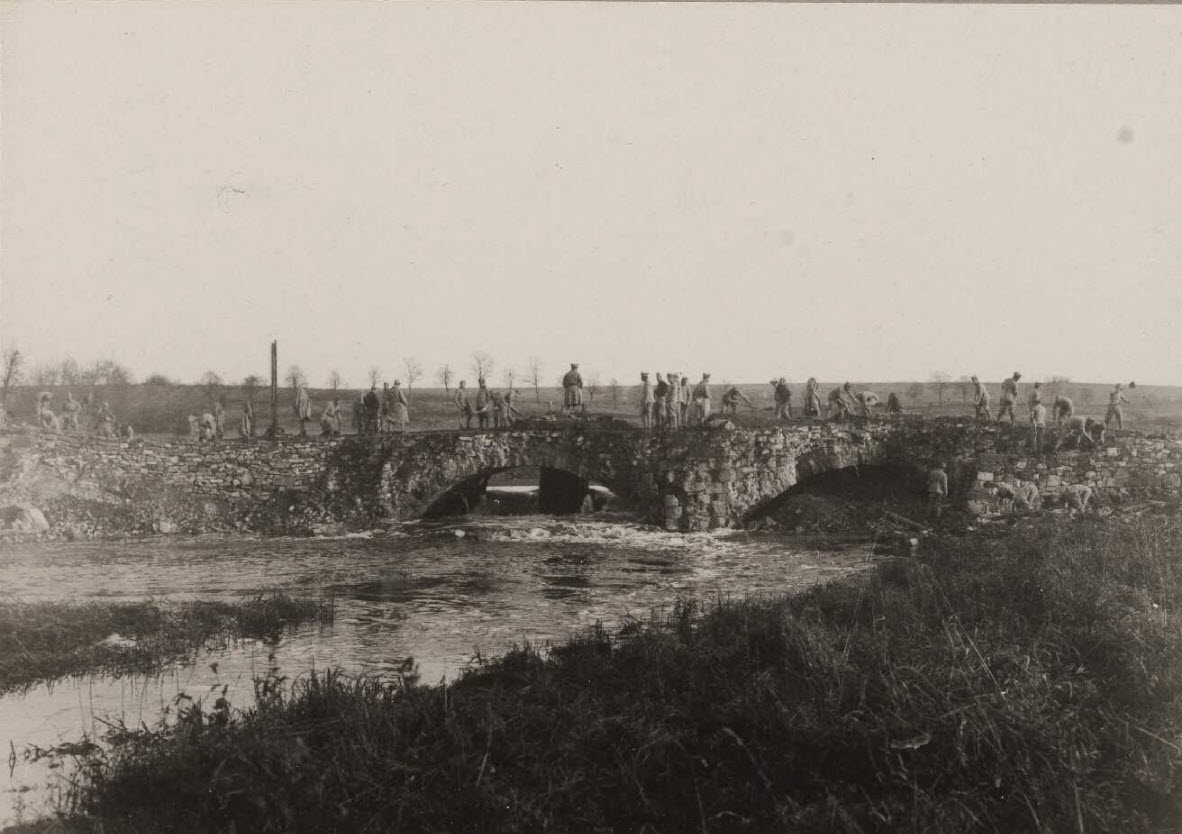
Left: Armaucourt village, where the 151 was billeted in the final weeks of the war, 14 November 1918. Right: French sappers repairing the bridge over the Seille River outside of Manhoué, 14 November 1918. Source: Vallois Collection.
12-16 November: The battalions remain in their positions. In the afternoon, 1 Bat. goes to billet at Lay - St. Christophe. The 3 Bat. detaches a company to Bey and another to Lanfroicourt to occupy surveillance posts looking over the passages of the Seille. The 2 Bat. remains in place. The situation remains unchanged for the next three days. To pass the time, soldiers from both sides went "grenade fishing" in the Seille, tossing the explosives in the water to stun fish to the surface. On 16 November, 1 Bat. departs Lay - St. Christophe and goes to billet at Bouxières-aux-Chènes, Ecuelles, and the Bois de la Haute-Côte. The other battalions remain in their positions and are put to work improving the state of the routes of communications in the region of Bey - Lanfroicourt, Pont-de-Manhoué, in light of a forward movement to begin on 17 November. The advance would begin by crossing the Seille River, which had marked the border between France and Germany since the end of the Franco-Prussian War almost fifty years before, when Germany had claimed the territories of Alsace and Lorraine as spoils of war.The 3, 7, and 9 Companies of the regiment previously dissolved on 1 October are now reconstituted.
17-18 November: The French 10th Army begins its advance forward. The 151 marches in column with the rest of the 69 ID (marching order: 162, 151, 129 RIs) to make its triumphal return to Lorraine, officers with their sabres, men with bayonets fixed, regimental colors unfurled, and the band at the front playing ‘Sambre et Meuse’. The itinerary was Manhoué, Jallaucourt, Lemoncourt. They first passed through a desolate land of empty enemy entrenchments and abandoned cannon, the inhabitants long since forcibly removed by the Germans. As they marched further, they began encountering civilians. At Delme, the band struck up the "Marche Lorraine" as they paraded past General Monroe. Between Tincry and Bacourt, alongside the road and on the slope leading up to the Bois de Tincry, the Lieut.-Colonel Martin ordered the regiment to form up into a square. Nearby was an important quarry abandoned by the Germans. Martin gave an emotional speech praising the men and the accomplishments of the regiment. When he concluded, from all the officers and men burst spontaneous shouts of "Victoire!" and other triumphant fanfares. The 151 would billet for the night at Morville-sur-Gied, Baudrecourt, and Bacourt, where the townspeople came out into the street and embraced the men as they marched in. Many of them were weeping with joy at seeing the liberating French soldiers, and knelt down to thank God and their patron St Martin for having delivered them. Lieut. Roger Basteau reported:
We set out early the next morning for Faulquemont, which the Boches had rechristened Falkenberg. In all the little villages our music played, the inhabitants, after having decorated with garlands, and make-shift homemade flags, cried out "Vive la France, vive les soldats!" In all these villages it was more or less the same touching welcomes. Thousands of Lorrainers sporting our Tricolor flag, hastened about to organize receptions for us both big and small. This went on for a week, as they organized balls, and played old Lorraine airs. Young and old alike, girls and women danced joyfully in the arms of the poilus who were overwhelmed on every side . . . Everywhere we went, there was feast after feast. In many houses the statue of Napoleon was set up in the windows.
The 151 marching trhough St. Avold on 23 November 1918.
In the final weeks of November, the 151 passed through Faulquemont, Saint-Avold, and Freymingen, close to the original German border prior to the annexation of Alsace-Lorraine. At long last, on 1 December, the unit marched into Germany, crossing the River Saar at Völklingen with bugles sounding. The inhabitants closed their doors as the Frenchmen passed, and from there on, the reception grew understandably colder. After billeting at Puttlingen, the 151 marched on to Homburg and began its mission of occupation. Though no hostilities would manifest itself between the German civilians and their French occupiers, the poilus were made to feel unwelcome. On 21 January 1919, the regiment was given one final award when the fourragère for the Medaille Militaire was added to the regimental colours by General Fayolle at Deux-Ponts (Zweibrücken), Germany. The 151’s mission as an occupational force would continue into 1919, with the 151 garrisoning in Kaiserslautern and Germersheim until the end of June, occasionally rotating back over the border into several picturesque Alsatian villages in the Vosges mountains.





